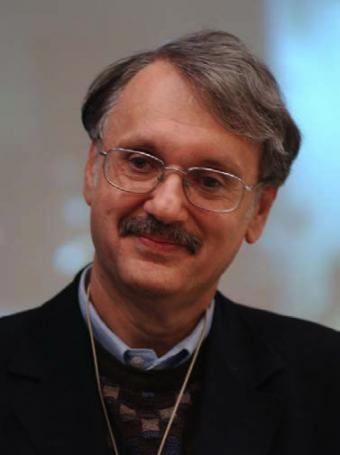PROVIDENCE, R.I. [Brown University] — In 1985 there was little hope for people with AIDS. Newspapers and television screens were filled with ghastly pictures of emaciated figures dying from a disease that had no cure.
Then a team of scientists at the National Institutes of Health’s National Cancer Institute announced it had come up with the first drug to combat AIDS, and related drugs discovered by this group followed. A quarter-century later in the “Age of the Genome,” there still is no cure for AIDS, but it is now highly treatable and it has become a chronic, manageable condition. That first drug, AZT, now a generic, remains in one of many combinations in use that form the backbone for a regimen that has been effective at allowing people with the disease to lead fruitful, normal lives.
Samuel Broder was the director of the Clinical Oncology Program of the National Cancer Institute when AZT was successfully tested. He later became NCI director, appointed by President Reagan. Now the chief medical officer at the biotechnology company Celera, Broder will speak about the AIDS pandemic and how AZT and related drugs changed public attitudes toward the disease.
Broder’s presentation comes as 17 leading thinkers from academia, business and government – including two Nobel laureates – will convene at Brown University for the Computational Molecular Biology Symposium, which runs from May 3 to 7. During those five days, participants will discuss advances in genomics, a field of research revolving around the wealth of data contained in the genomes of microbes, plants and animals. With the goal of better understanding human development and evolution, disease and behavior, computational biology is booming, evidenced by a burst of new research programs and new start-up companies.
The group also will hold wide-ranging talks on the the legacy of the famous physicist and computer pioneer John von Neumann, and six guests of the University will participate in the John von Neumann Distinguished Lecture Series.
Sponsored by Brown University, the Center for Computational Molecular Biology and the Department of Computer Science, the symposium is free and open to the public. Registration is required. All sessions will be held in the Thomas J. Watson Sr. Center for Information Technology, located on the Brown campus at 115 Waterman St.
Broder’s talk is scheduled to begin at 9 a.m. on May 7. It is titled “The Development of Antiretroviral Therapy and Its Impact on the Global HIV-1/AIDS Pandemic: Personal Reflections on a Journey to Treat an ‘Untreatable’ Virus After 25 Years.”
Speakers will explore new horizons in genomics during the three-day section (May 5-7) of the symposium titled, “The Genome and the Computational Sciences: The Next Paradigms,” supported by a series of question-and-answer forums dubbed “sweat box sessions.” Among the speakers will be Eric Davidson, a cell biologist at the California Institute of Technology who first mapped the genome of a sea urchin; Richard Lewontin, a pioneer of population genetics at Harvard University; David Shaw, chief scientist at D.E. Shaw Research and a science adviser to President Obama; Martha Bulyk, a comparative genomics specialist at Harvard Medical School; and Jonathan Yewdell, chief of the cellular biology section in the Laboratory of Viral Diseases at the National Institute of Allergy at the NIH.
The symposium will begin with two days of talks (May 3-4) celebrating the life of John von Neumann, a trailblazing physicist who is perhaps best known his role in the early development of computers. As director of the Electronic Computer Project at Princeton’s Institute for Advanced Study in the 1940s and 1950s, von Neumann developed MANIAC (mathematical analyzer, numerical integrator and computer), which at the time was the fastest computer of its kind. Von Neumann’s daughter, Marina von Neumann Whitman, professor of business administration and public policy at the University of Michigan, will reflect on her father’s accomplishments. Other speakers include Leon Cooper, Brown professor and Nobel laureate in physics; Ken Arrow, Nobel laureate in economics; and John Conway, the John von Neumann Professor of Mathematics at Princeton University.
“We are all excited to hear speakers of the highest scientific stature in biology, computer science, economics, mathematics and physics who will lecture on the von Neumann legacy and the Genome era,” said Sorin Istrail, the Julie Nguyen Brown Professor of Computational and Mathematical Sciences, professor of computer science and chair of the symposium.
The symposium comes as Brown expands its programs in genomics and computation. This fall, the University will welcome its first class of doctoral candidates in computational molecular biology. The Ph.D. program will train students in computational, mathematical, and statistical sciences while providing a foundation in molecular biology.
More information about the symposium, including a detailed schedule of presentations, is available at www.brown.edu/Research/CCMB/Conferences/SYMPOSIUMMAY2010/info.
The Center for Computational Molecular Biology
The Center was founded in September 2003 at Brown with the aim of establishing a world-class center for research and scholarship in the emerging field of computational biology. The central mission is to make breakthrough discoveries in the life sciences at the molecular and cellular level through the creative application of existing data analytic methods and the development of novel computational, mathematical, and statistical technologies required exploit the opportunities emerging from advances in genomics and proteomics. Istrail is the Center’s director.

